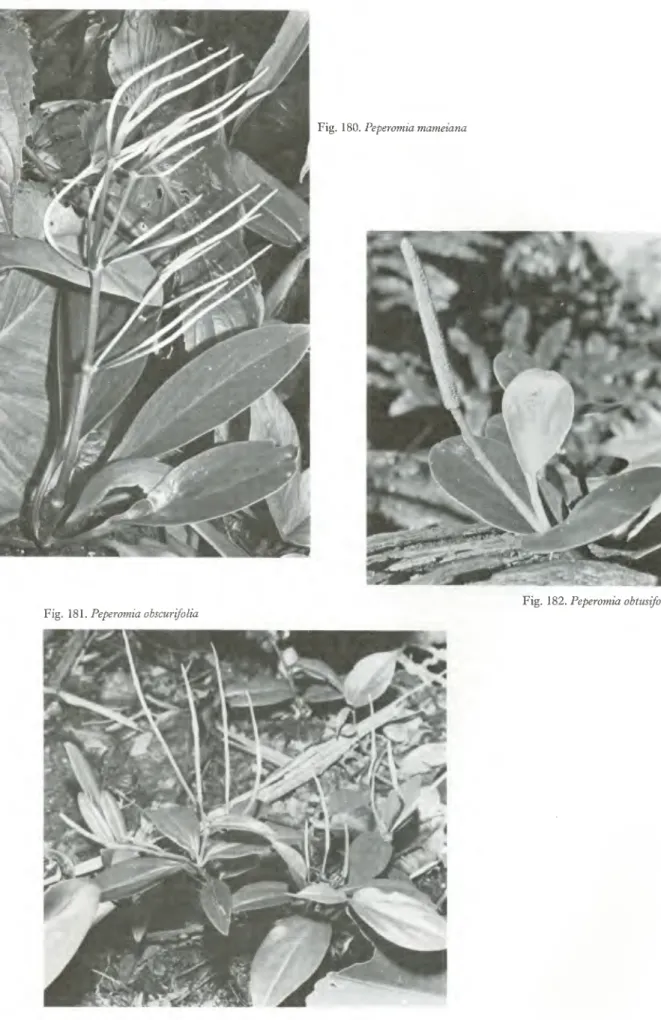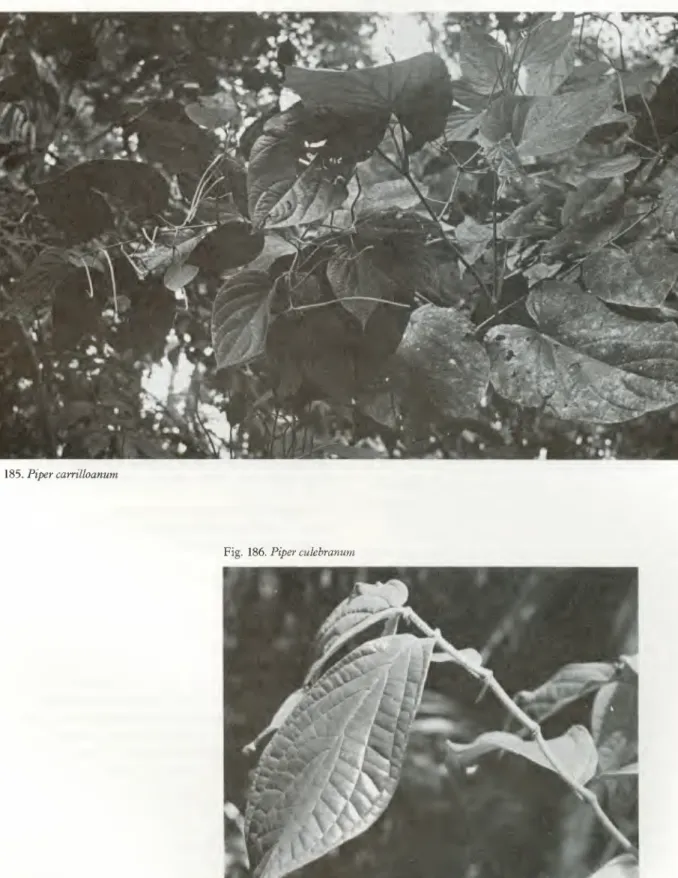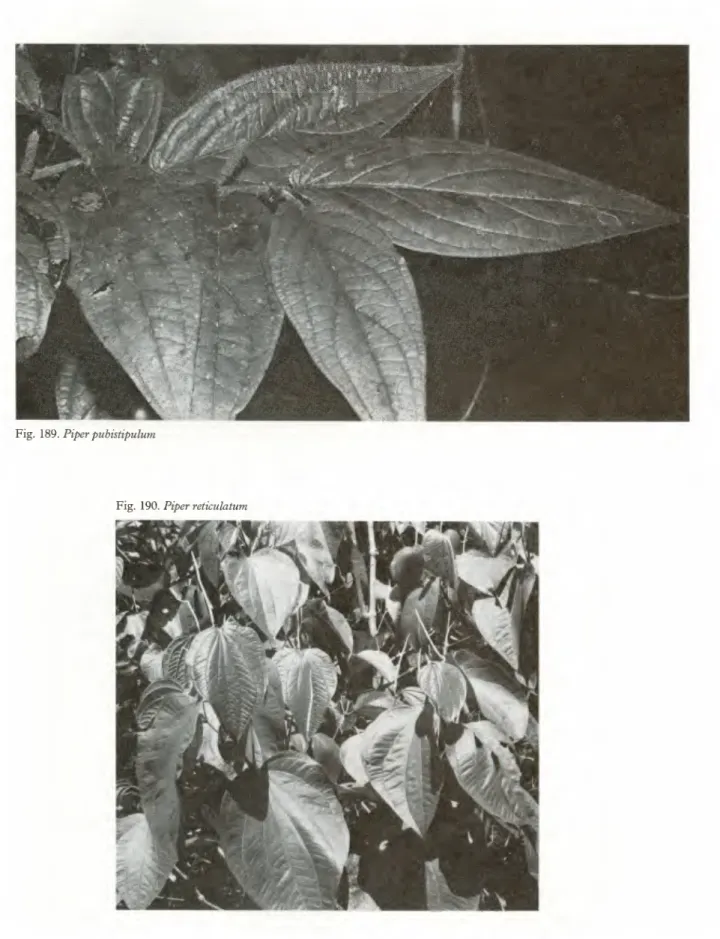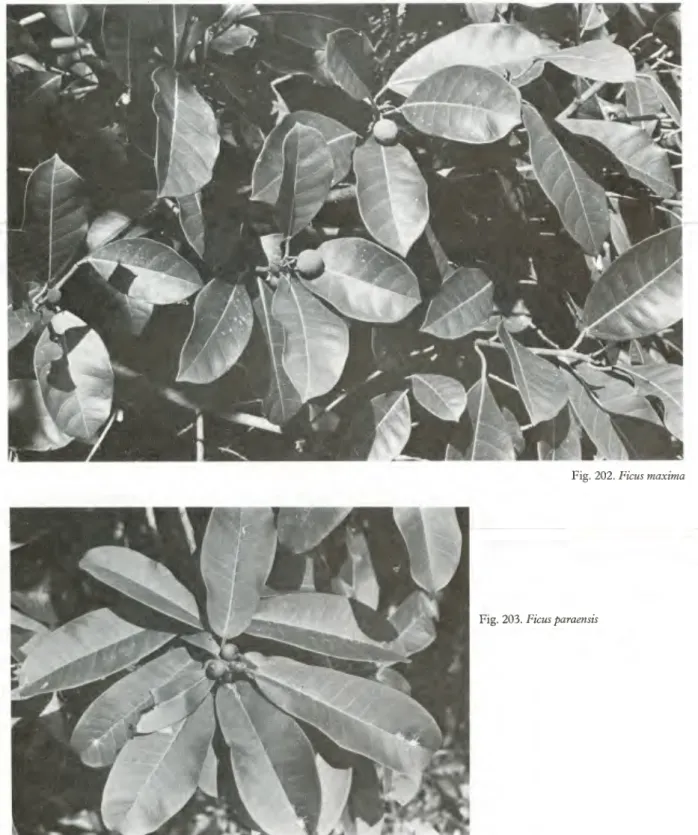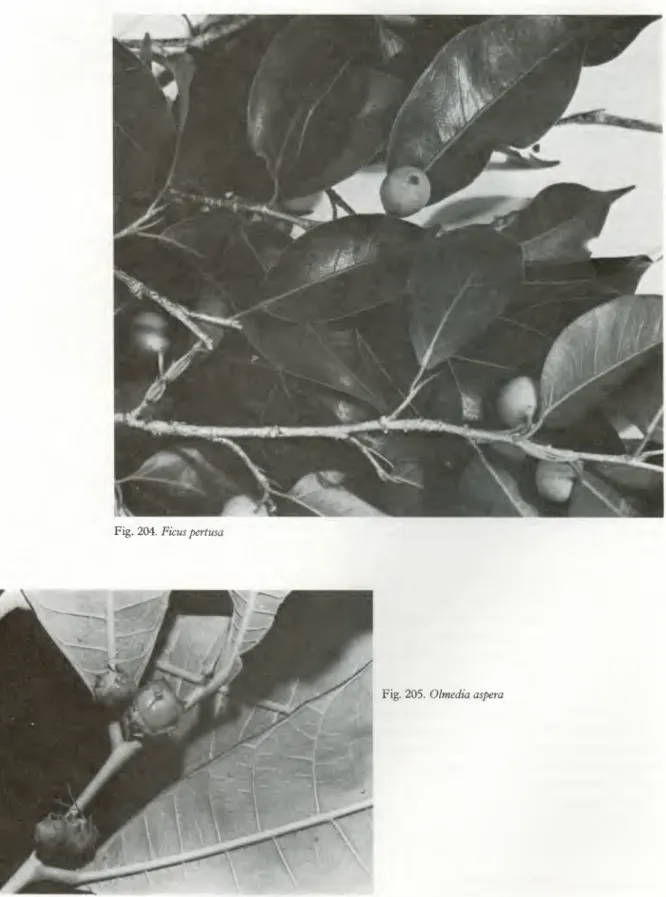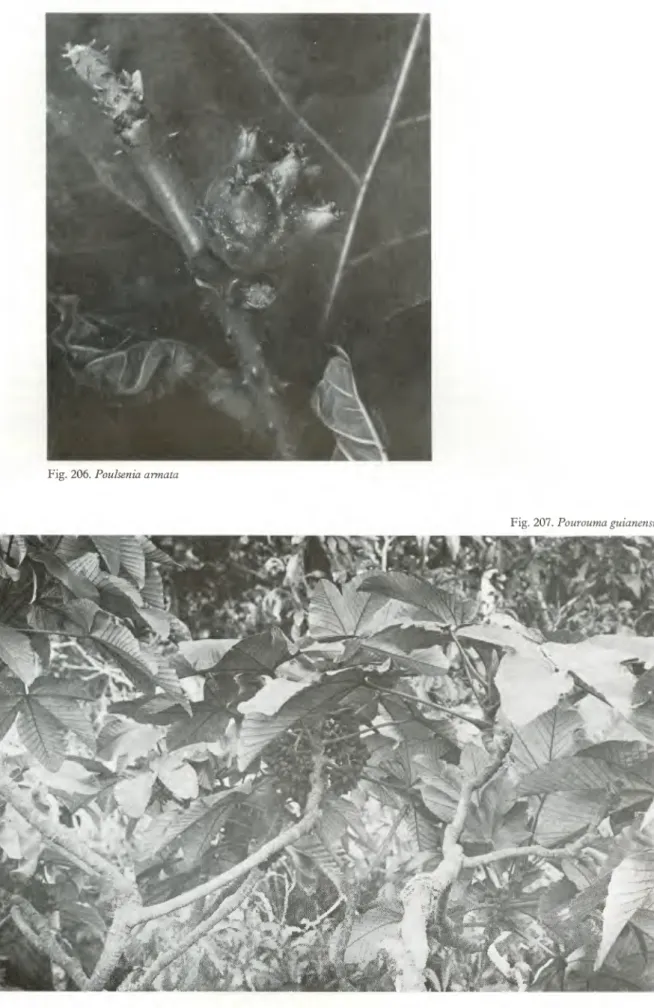Leaflets opposite, mostly rounded or convex at the top, pointed at the base, 3.5-10 cm long, 0.6-1.5 cm wide, glabrous, coriaceous (when dried they are markedly longitudinally striated). In Panama, known from tropical moist forests in the Canal zone (both slopes) and from premontane wet forests in Code (Rio Anton, 500-600 m) and Panama (Cerro Campana).
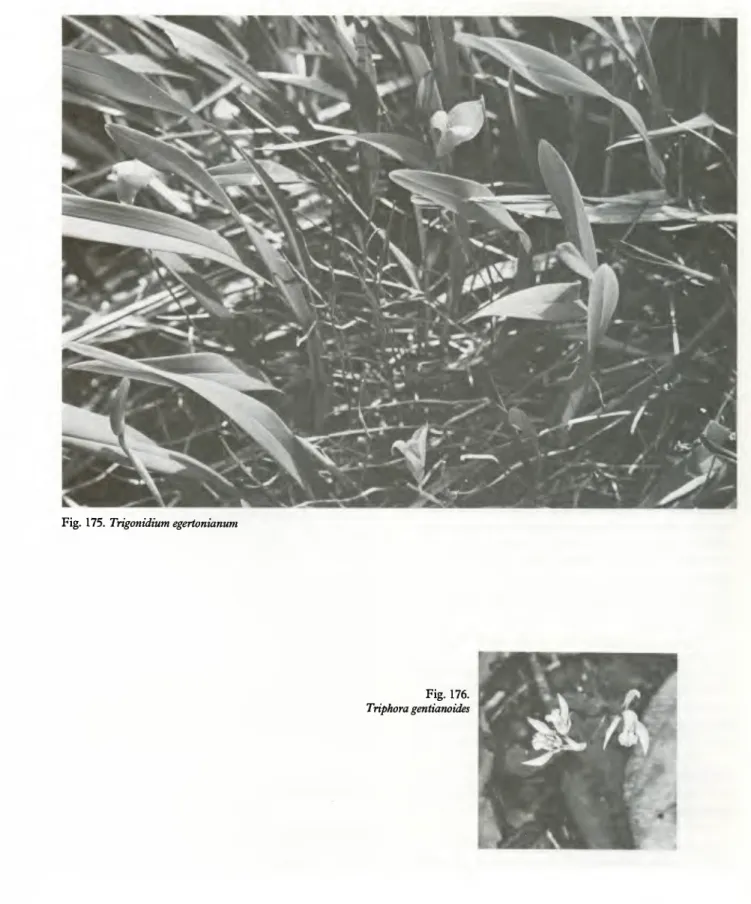
Petals with petal-like scales on the inner surface; stamens 8; plant vines or trees; fruits capsular, the seeds arillate 80. SAPINDACEAE (partial) Petals without appendage; stamens 5, 10 or more; plants not sparingly; fruits not shelled.
KEY 4: PLANTS LACKING LEAVES AND/OR CHLOROPHYLL Plants growing on the ground, saprophytic
Inflorescences enclosed by and partially enclosed by a pair of large bracts; flowers apetalous, distinctly unisexual; stamens many.
KEY 5: BLADES SIMPLE; FLOWERS INCONSPICUOUS, MINUTE, USUALLY CROWDED;
Sepals and petals 4; plant shrubs or small trees, never scandalous; fruits of 1 (2) obovoid, fleshy heads; petals with scales attached to the inner surface. Flowers in pencil-like spikes; epiphytic herbs (Peperomia), terrestrial herbs (Pothomorphe), or shrubs or trees with opposite spikes of leaves {Piper) 36.
Stamens are equal in number to petals and ± hidden by petals; leaves with large glands at the base. Leaves not pleated; inflorescences with neuter flowers consisting only of enlarged calyx lobes; epiphytic plants; fruits small capsules.
LYTHRACEAE (Cuphea carthagenensis (Jacq.) Macbr.) Flowers without a hypanthium and with 4 white petals; stamens 4 and didyn-. TRIGONIACEAE (Trigonia floribunda Oerst.) Flowers actinomorphic or yellow or red and zygomorphic; stamens not united in.
PIPERACEAE
Petals 4, thin; petioles of varying length on the same plant, 1-20 cm long; fruits purple schizocarps 59. Leaves scaly within about 1 cm of margin; peduncles thick, 1-5 cm long; leaflets broadly ovate to round-ovate, acute to acuminate at apex, rounded at base, 3-11 cm long, 2.5-8.5 cm wide, dry thin but firm, palmately veined, veins indistinct.
PIPERACEAE/PEPEROMIA Leaf blades seldom if ever orbicular, mostly more than 1.5 cm long
In Panama, known from tropical moist forest in the canal zone (near Gatun Lake), Bocas del Toro and eastern Panama. In Panama, known from tropical moist forest in the Canal Zone, Veraguas and Panama and from tropical wet forest in Code.
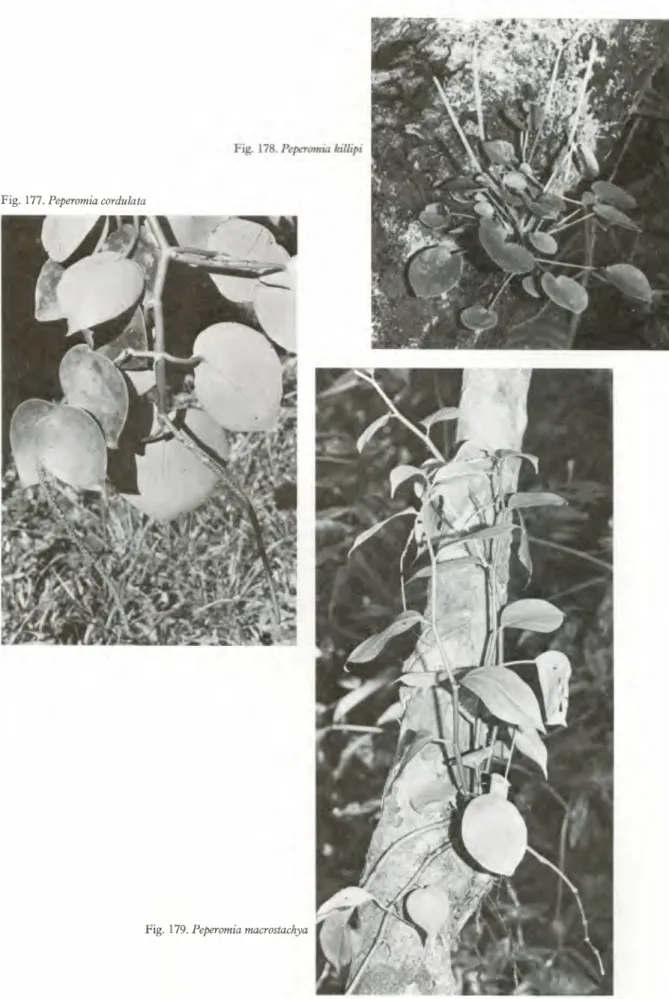
PIPERACEAE/PIPER Leaves mostly glabrous below except for band of coarse short trichomes between
In Panama, known only from tropical moist forest in the Canal Zone (around Lake Gatun) and in Colon. Known only from Panama, from tropical moist forest in the Canal Zone and Panama (San Jose Island).
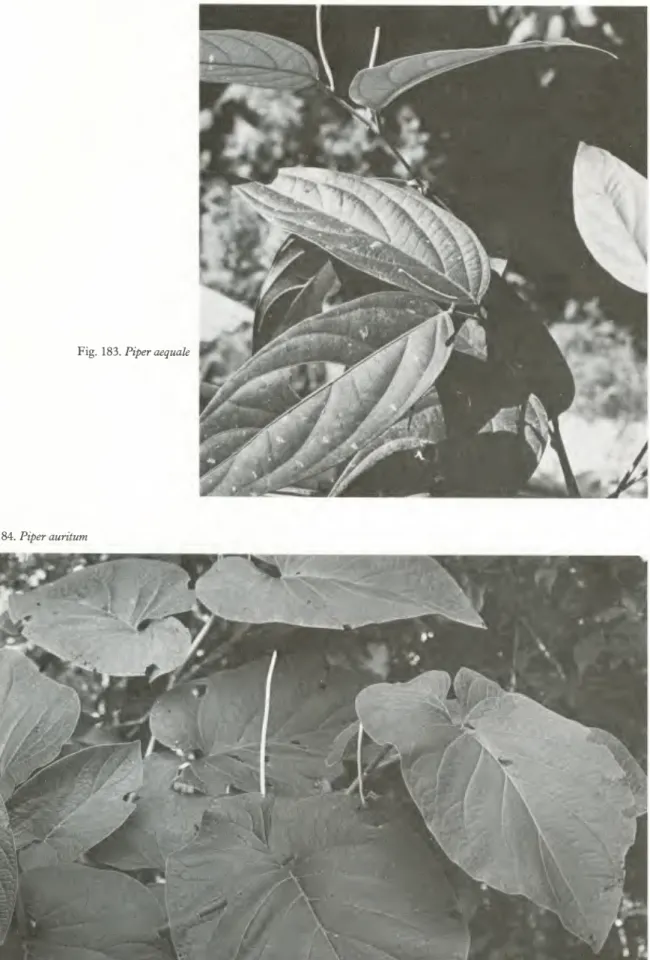
LACISTEMACEAE
In Panama, known from tropical moist forests in the Canal Zone, Bocas del Toro, Colon, Chiri-qui, Panama and Darien. In Panama usually below 1000 m; known from tropical moist forest in the Canal Zone, Bocas del Toro, San Bias, Panama and Darien, from tropical moist forest in Colon and from foothill rainforest in Chiriqui (Boquete), Colon and Coda (El Valle) .
ULMACEAE
Cymes axillary, up to 1.5 cm long; flowers small, 5-parted, green, greenish-yellow or whitish; sepals up to 1.3 mm long, finely pubescent. In Panama, ecologically variable and widespread in logged areas; known from tropical moist forests throughout Panama, from tropical dry forests in Coda, from premontane moist forests in the Canal Zone, from premontane moist forests in Chiriqui, Coda and Panama, from tropical moist forests in Colon and Veraguas, and from premontane rainforests and lower montane wet forests in Chiriqui.
MORACEAE
In Panama, known from tropical moist forest in the Canal Zone and Panama (San Jose Island). In Panama, known from tropical moist forest in Canal Zone (BCI) and Panama (San Jose Island) and from premontane wet forest in Code (El Valle).
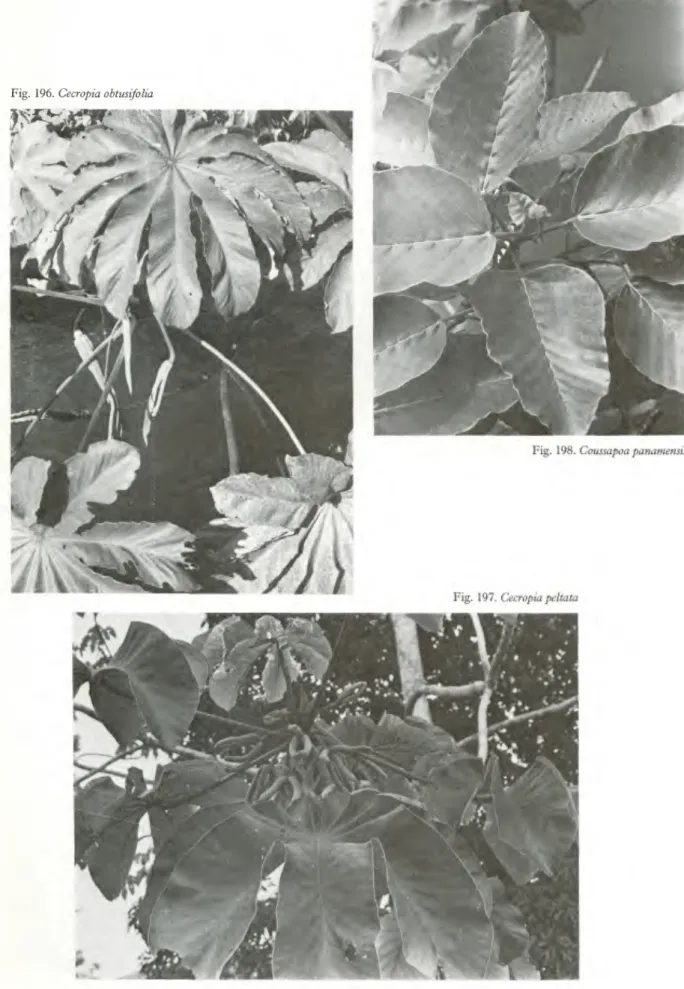
URTICACEAE
In Panama, known from tropical moist forests in the Canal Zone, Bocas del Toro and Darien (Duke, 1968). In Panama, known from tropical moist forests in the Canal Zone, Bocas del Toro, San Bias, Code and Panama.
PROTEACEAE
Flowers in the late dry and early rainy seasons, from April to September, especially in July and August. The fruits usually ripen from September to December, but sometimes also in the early dry season.
LORANTHACEAE
In Panama, known from tropical wet forest in the Canal Zone, Bocas del Toro, Colon, Chiriqui, Panama and Darien and from premontane wet forest in Bocas del Toro, Code and Panama. Known in Panama from tropical moist forest in the Canal Zone, Bocas del Toro, Colon and Veraguas, from premontane moist forest in Panama, and from premontane wet forest in Chiriqui, Panama and Darien.
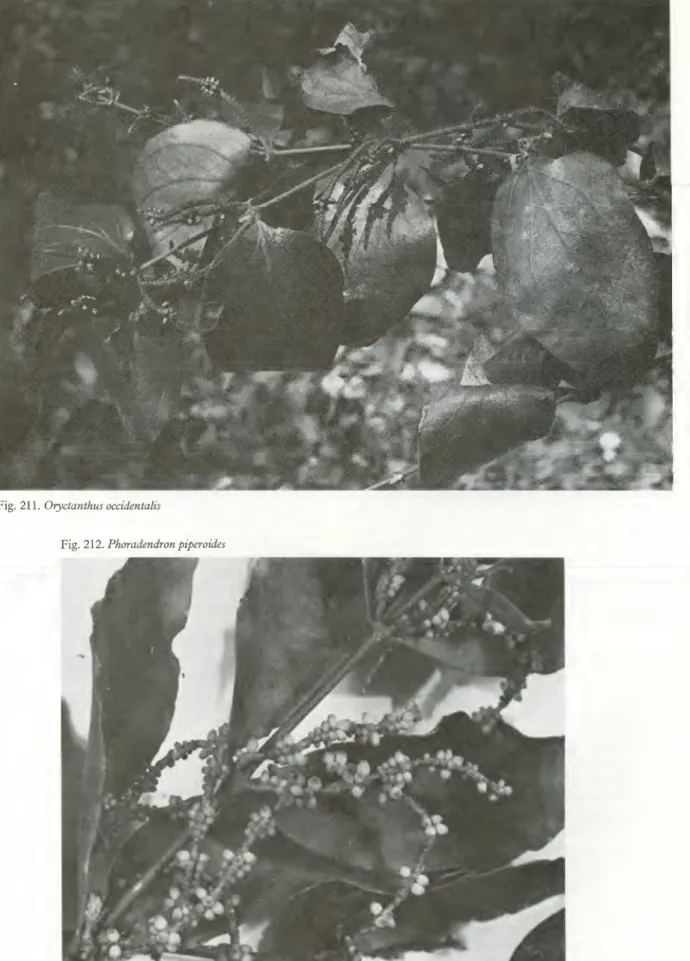
OLACACEAE
The plants are visibly hairy in most parts; calyx limb less than 3 cm long; capsules ovoid, about 6 cm long A. capsules ovoid, about 6 cm long and 4 cm wide, removed from the base, bearing many seeds; disc-shaped seeds, about 1 cm in diameter.
RAFFLESIACEAE
Flowers in short, few-flowered racemes, white, densely dotted with pink and maroon; calyx expanded into a ± campanulate balloon up to 8 cm long, narrowed into a short tube opening bent into a large limb up to 20 cm long;. Capsule cylindrical, up to 13 cm long and about 3 cm wide, dehiscent at the base, many-seeded; seeds 7-8 mm long, flattened, elliptic, lips bordered by a pronounced medial rib, very revolute, truncate valves about 1.5 cm wide.
POLYGONACEAE
Leaves less than 10 cm long, ovate, narrowly very long-pointed at the tip, rounded at the base, borne on a short shoot approx. 1 cm long; inflorescences approx. 1-2 cm long C. Pistillate inflorescences usually less than 10 cm long, flowers solitary at each node; stamens rudimentary; pistil 2 mm long;.
AMARANTHACEAE
Leaves opposite; petioles 2-10 mm long; leaves broadly ovate to elliptic or ovate, acuminate and mucronulate at apex, cuneate at base, to 6 cm long and 3 cm wide, villous when young, becoming sparsely villous to glabrate. Utricles indehiscent, suborbicular, membranous, to 1.5 mm long, shorter than sepals; seeds reddish brown, to 1.2 mm long.
AMARANTHUS L
NYCTAGINACEAE
Known only from Panama, where it is ecologically variable; known from tropical dry forest in Panama, from tropical moist forest in the Canal Zone and Darien, and from probably premontane wet forest in Colon (Santa Rita Ridge). In Panama, known from tropical moist forest in the Canal Zone and Panama, from premontane moist forest in Panama and from premontane wet forest in Code.
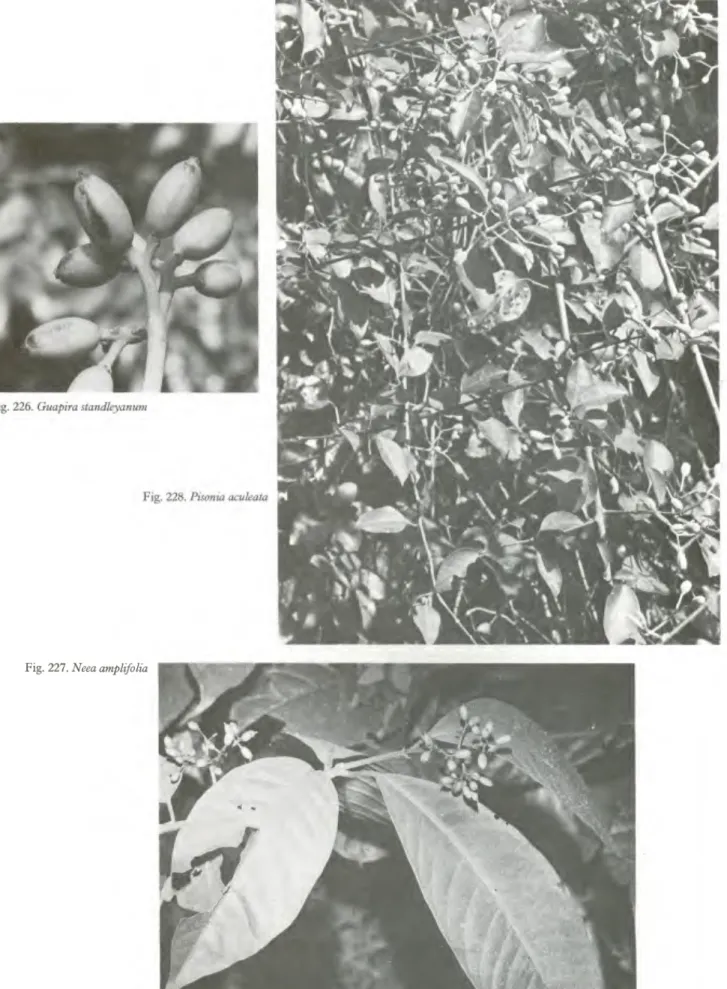
PHYTOLACCACEAE
Bocas del Toro, Panama and Darien and from dry tropical forest in Panama (Island of Taboga). In Panama, known from tropical moist forests in the Canal Zone, Bocas del Toro, Colon, San Bias, Panama and Darien, from tropical dry and premontane wet forests in Code and from tropical wet forests in Chiriqui.
PORTULACACEAE
In Panama, known from tropical moist forest in the Canal Zone, Bocas del Toro, San Bias, Los Santos, Panama and Darien, from premontane wet forest in Colon, Chiriqui and Panama, and from premontane rainforest in Code and Darien. In Panama, known from disturbed areas of tropical moist forest in the Canal Zone, Bocas del Toro, Colon, Los Santos, Code, Panama and Darien; Also known from the wet premontane forest in Chiriqui (Boquete).
CARYOPHYLLACEAE
NYMPHAEACEAE
Leaves often more than 20 cm long, usually purplish below, margin toothed, veins coarse, prominently raised on lower surface N. Leaves less than 15 cm long, usually green below, entire, veins fine, not raised below.
MENISPERMACEAE
The solid inflorescences are narrow pseudoracemose, 5-10 cm long, the twigs reduced to short-stalked, 3-flowered cymes; pedicels up to 1.7 mm long; Drupes oblong-ovate, about 1.5 mm long, narrowed at the base into a short needle, coarse to glabrous in age.
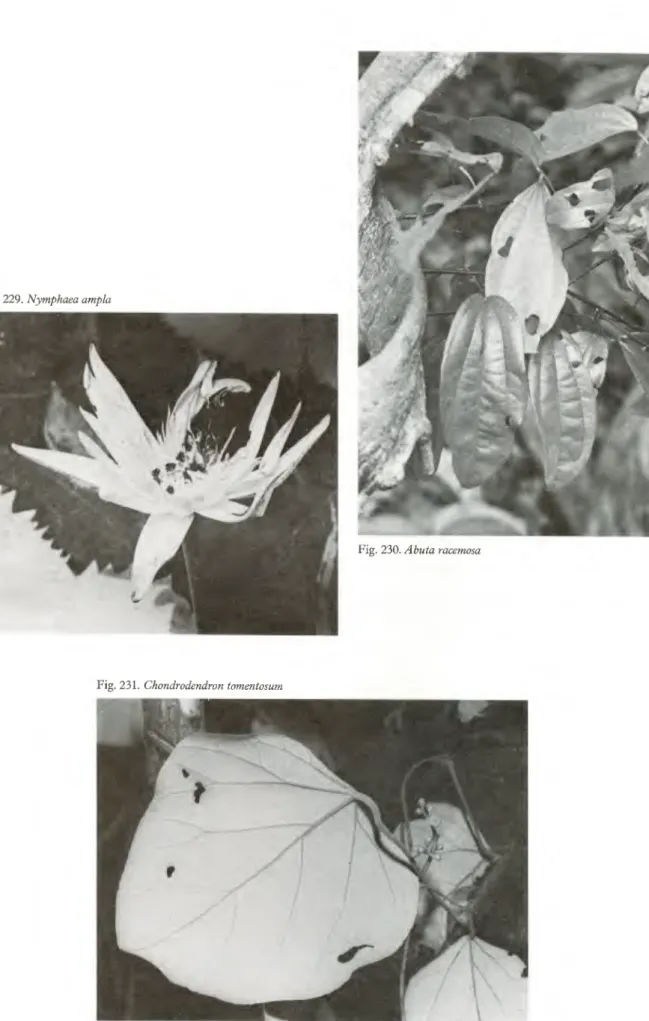
ANNONACEAE
Known only from Panama, from tropical moist forest in the Canal Zone (on and adjacent to BCI) and Panama. Known only from Panama, from tropical moist forest in the Canal Zone, Bocas del Toro and Darien.
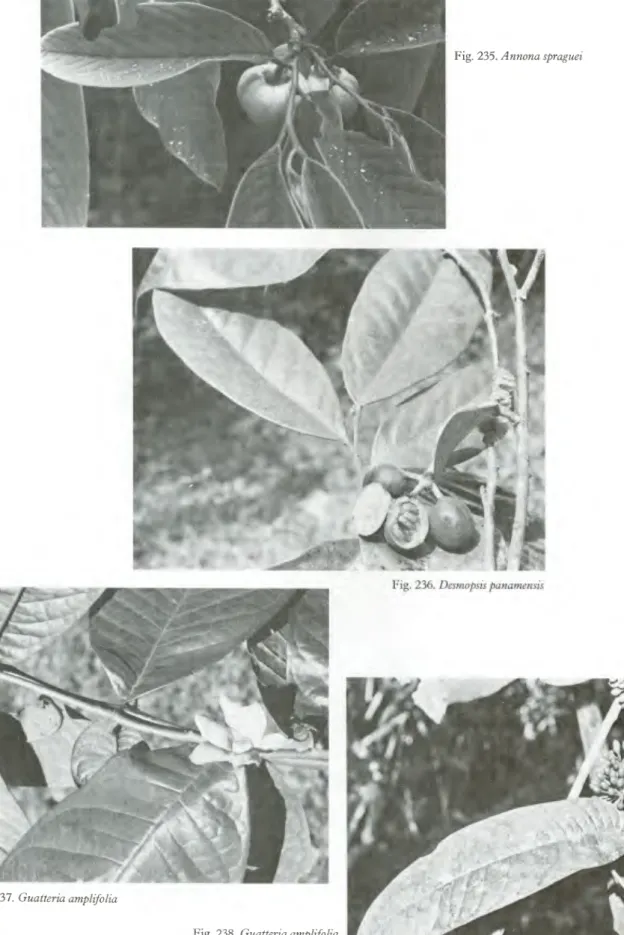
MYRISTICACEAE
In Panama, known from tropical wet forest in the Canal Zone, Bocas del Toro, Chiriqui, Panama and Darien, from premontane wet forest in Panama and from tropical wet forest in Colon and Darien. Capsules ovoid-ellipsoid, thick-walled, bright orange, 3-3.5 cm long, bearing dense, short, stellate pubescence; valves 2, woody, ca. 5 mm thick, splitting widely at maturity; seed 1, ellipsoid, approx. 2 cm long, the spike deeply laciniate, red when ripe (white until just before ripening), fleshy, tasty but becoming bitter soon after being chewed.
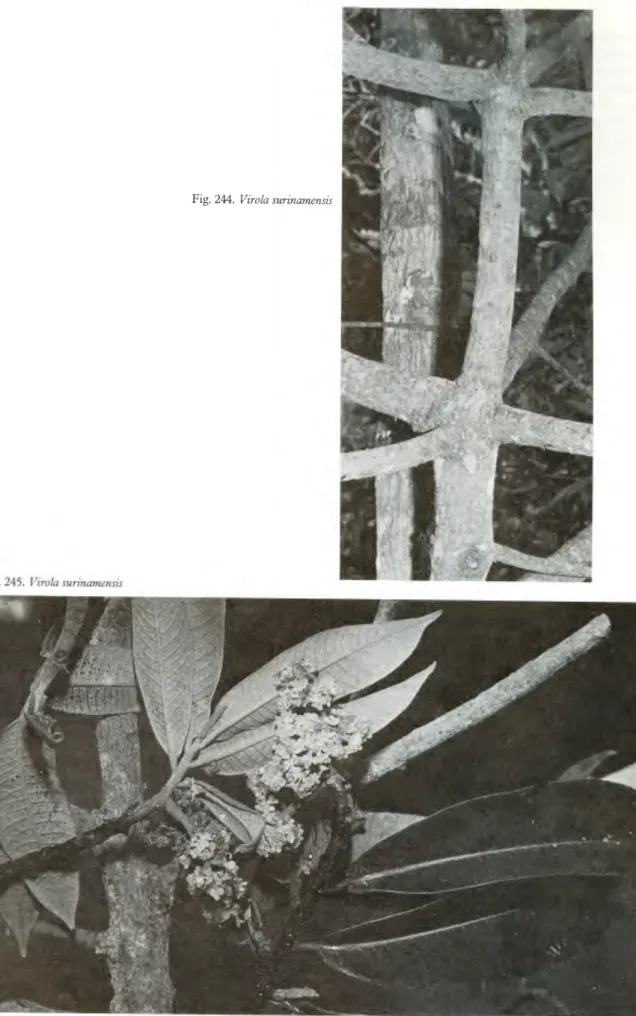
MONIMIACEAE
Fruits numerous per cyme, grape-like, aggregate, enclosed in hypanthium, ± globose, to 1.5 cm diam, reddish-yellow when ripe, bursting irregularly; seed approx. 6, tubercular, greyish. Not collected in recent years on the island; several earlier collections were made, but the species may have been replaced during succession in recent years.
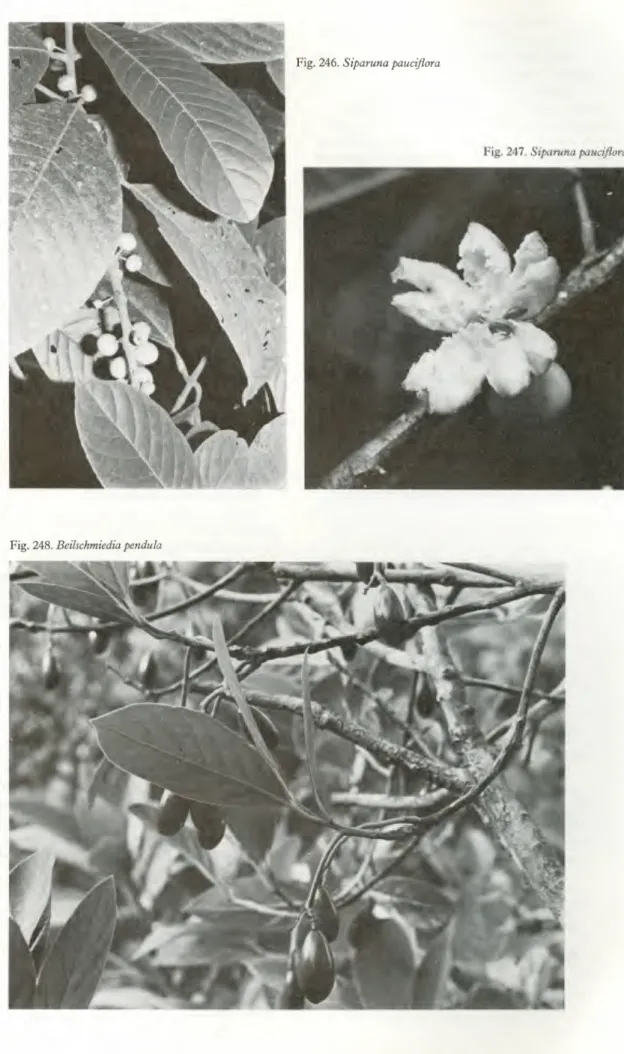
LAURACEAE
Often along the coast, especially on the northern side of the island; occasionally in younger forest. Uncommon, along the coast, especially on the northern side of the island and in the young forest.
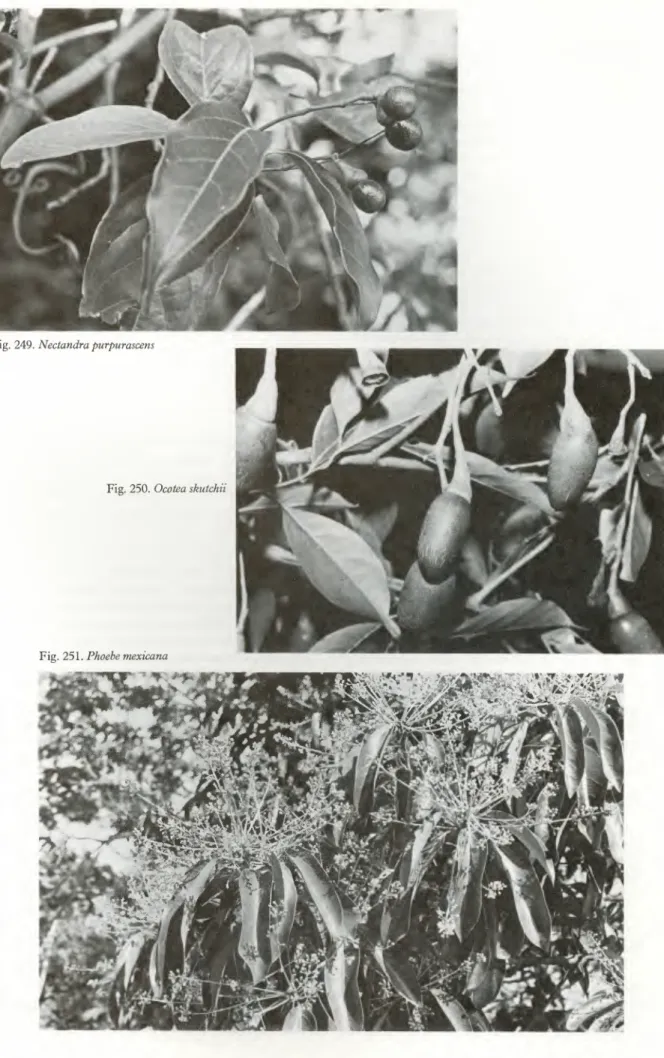
CAPPARIDACEAE
In Panama, occasionally in tropical moist forest in the Canal Zone, Panama and Darien, especially on the Atlantic slope, or at intermediate elevations of the Pacific slope as in Panama (lower slopes of Cerro Campana). In Panama, known from tropical moist forest in the Canal Zone on the Atlantic Slope and in Darien.
SAXIFRAGACEAE
CHRYSOBALANACEAE
Drupes oblong-obovate, up to 1.5 cm long, about 6 mm diam, purplish brown turning black, sparsely hairy. Petioles up to 5 mm long, moderately hairy; stipules paired, subulate, up to 5 mm long, sub-persistent; blades elliptic-oblong, acute at apex, acute to rounded or subcordate at base cm long, 1.5-5 cm wide, glabrous above except on midrib, sparsely pubescent below, the trichomes denser on veins.
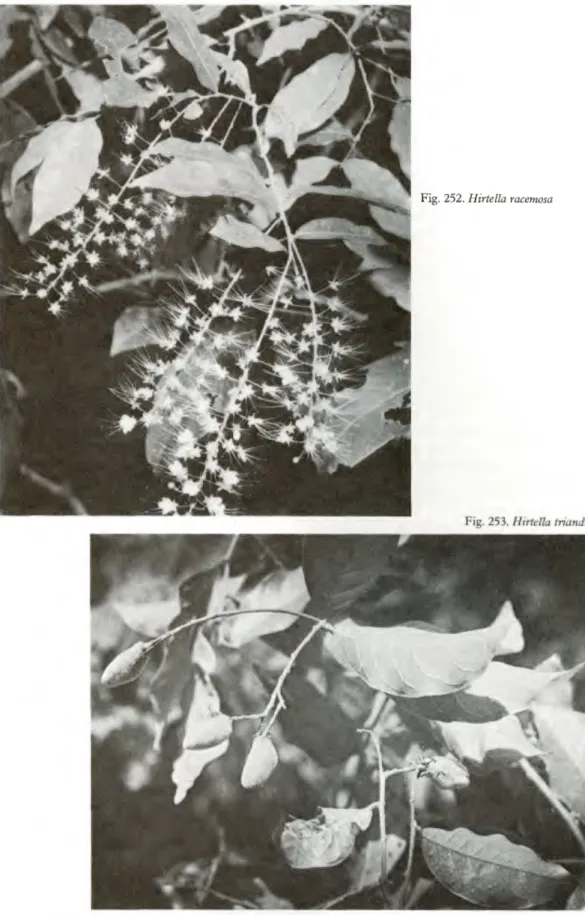
CONNARACEAE
Abundant along the coast; less common in forest canopy, especially young forest. Known only from Panama, from tropical moist forests in the Canal Zone, Colon and Darien.
LEGUMINOSAE (FABACEAE)
In Panama, known from tropical moist forest in the Canal Zone (Atlantic Slope), Bocas del Toro and Colon and from tropical dry forest in Panama (Taboga Island). In Panama, known mainly from tropical moist forest in the Canal Zone (mainly on the Pacific slope) and in Colon, Chiriqui (Puerto Armuelles), Panama and Darien; also known from the moist premontane forest in Chiriqui (Boquete) and Code and from the tropical wet forest in Colon (Salud).
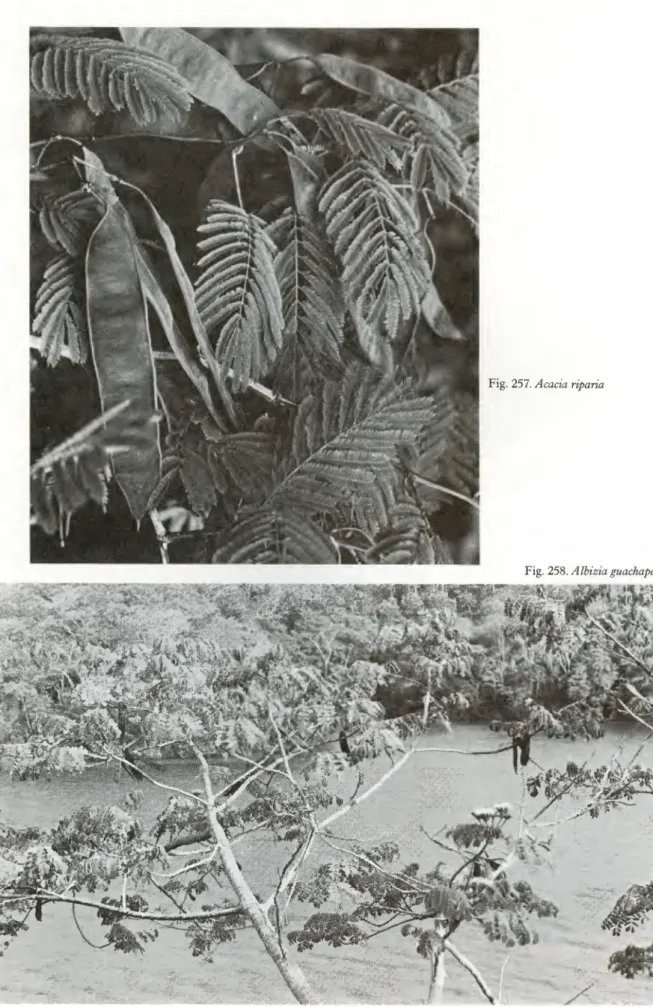
OXALIDACEAE
Fruits samaroid, ca 8.5 cm long, 1-seeded, yellowish green, glabrous except sparsely appressed-pubescent on the ventral margin of the seminiferous region, the seminiferous region ca 3 cm long, oval, with a conspicuous, almost medial margin, this edge is continuous with the dorsal edge of the wing; wing obovate, mucronate at the apex, thin, about 5.5 cm long, the dorsal edge thickened. Leaves trifoliate; stipules narrow lanceolate, 4-7 mm long, curved at the base, the lobes up to 1 mm long; petioles 1.5-4 cm long; rachis 5-15 mm.
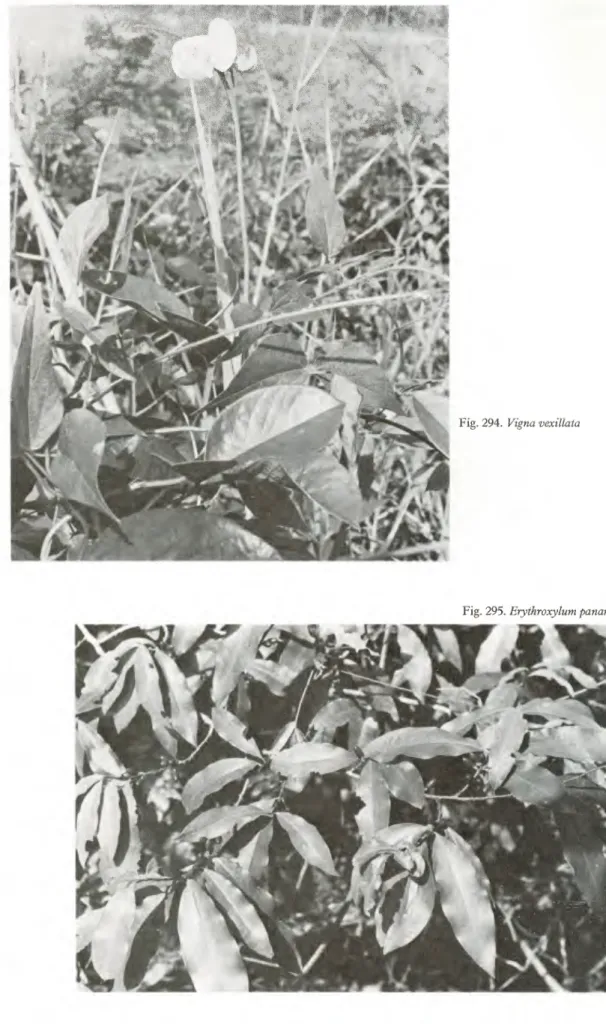
HUMIRIACEAE
Leaves very sparsely hairy throughout; deltoid punctate, about 3 mm long; petioles 3-7 mm long, dry brown, channel-shaped; blades ± elliptic, acute at apex and base, 4.5-11 cm long, 2-4 cm wide, with discolored area about 5 mm wide on both sides of midrib below. Flowers solitary or trailing on stems, 5-parted; pedicels 1-2 mm long, with well-marked, rounded corners; calyx deeply lobed, the lobes valvate, acute, about 1.3 mm long; petals.
RUTACEAE
Petioles more than 1 cm long; blades longer than 12 cm; stipules more than 10 mm long; bracts covering the inflorescence equal to or longer than the length of the pedicels E. Petioles less than 7 mm long; blades shorter than 11 cm; leaflets less than 3 mm long; bracts, the inflorescences of which are much shorter than the peduncles of E.
RUTACEAE/CITRUS 489
It is apparently of Indochina origin; now widely cultivated in the tropics and subtropics and throughout Panama. In Panama, known from tropical moist forests in the Canal Zone, Panama and Darien and from premontane wet forests in Chiriqui (Progreso) and Panama (Cerro Campana).

SIMAROUBACEAE
Flowers large (more than 2 cm long), bright pink, bisexual; fruit in a wide receptacle, red, drupe 3-5, black, ovoid; rachis and petiole conspicuously winged Quassia amara L. Flowers unisexual, campanulate, green, in terminal panicles about 30 cm long; peduncles and pedicels often small puberulent; pedicels 5-15 mm long; calyx shallowly bowl-shaped, 5-lobed, the lobes acute, with small cells; petals 5, ovate to elliptic, beaked at apex; staminate flowers 4-5 mm long; stamens 10, lobes equal, in 2 whorls, inner whorl about 4 mm long, outer whorl slightly shorter; filaments subulate, appendages dense; gynoecium rudimentary, cushion-shaped, weakly 5-lobed, the trichomes tufted, forming a ring around the outer margin; pistillate flowers 3-3.5 mm long; pistil ± oblong, deeply 5-lobed, 5-locular; style about 1 mm long, stout; stigmas 5, thin; carpels 5, soon becoming free (usually no more than 3 survive to maturity); staminodia much shorter.
BURSERACEAE
In Panama, known only on the Atlantic slope from tropical moist forest in the Canal Zone, Bocas del Toro and San Bias, from tropical wet forest in Colon and Code, and from premontane wet forest in the Canal Zone and Colon. In Panama, known only from tropical moist forests in the Canal Zone, Chiriqui, Panama and Darien.
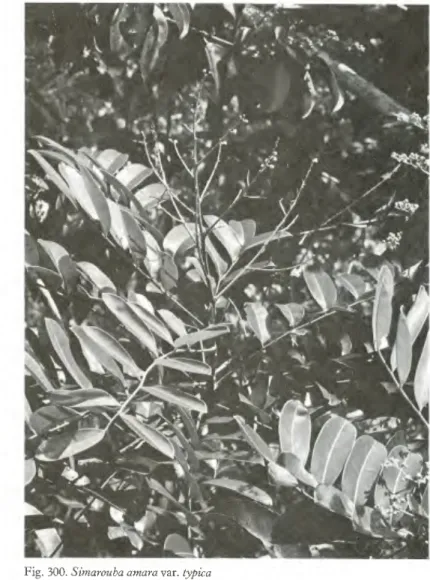
MELIACEAE
